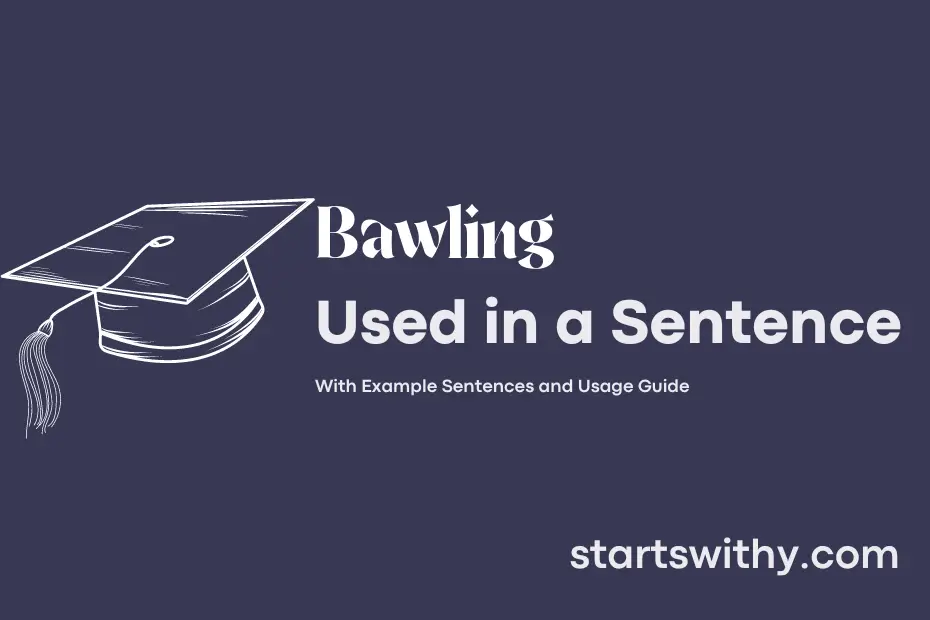Have you ever come across the word “bawling” in a text or conversation and wondered what it meant? Essentially, “bawling” refers to loud and uncontrollable crying or weeping, often accompanied by intense emotion.
In literature and everyday language, the term “bawling” is commonly used to describe someone who is crying loudly and openly, conveying a deep emotional response. Whether in a novel, a news article, or a personal anecdote, “bawling” paints a vivid picture of tears and distress.
7 Examples Of Bawling Used In a Sentence For Kids
- The baby was bawling for milk.
- The little girl was bawling because she lost her toy.
- The puppy was bawling for some treats.
- The boy started bawling when he fell off his bike.
- The cat was bawling for attention.
- The man was bawling because he was so happy.
- The girl was bawling because she missed her parents.
14 Sentences with Bawling Examples
- Bawling in the middle of a crowded classroom is never a good idea.
- Long hours of studying can sometimes lead to bawling out of frustration.
- Bawling after a breakup is completely normal, but make sure to take care of yourself afterwards.
- Group projects can be stressful and may result in someone bawling out of sheer pressure.
- Bawling over a failed exam is understandable, but it’s important to learn from the experience and move on.
- Bawling on the phone to a friend can sometimes be a cathartic way of releasing pent-up emotions.
- Bawling during a presentation can be embarrassing, but remember that everyone makes mistakes.
- Bawling in the library can disturb others, so it’s best to find a private space to let out your emotions.
- Bawling after receiving constructive criticism can show vulnerability, but also a willingness to learn and grow.
- Bawling at a college event may attract attention, so it’s okay to step outside to compose yourself.
- Bawling during a challenging internship experience can happen, but seek support from mentors and colleagues.
- Bawling while studying late at night is not uncommon, especially during exam season.
- Bawling in front of a professor may seem unprofessional, but they are there to support you through difficult times.
- Bawling over a missed opportunity can be tough, but remember that there are always other opportunities waiting for you.
How To Use Bawling in Sentences?
Bawling is used to describe crying loudly or sobbing uncontrollably. To use bawling in a sentence, first identify a situation where someone is crying loudly. For example, “After the news of her pet’s passing, she was bawling inconsolably.”
When constructing a sentence with bawling, ensure that it is clear from the context that the person is crying loudly or wailing. You could say, “The child lost his favorite toy and started bawling in the store.”
Remember that bawling is a strong word that indicates intense emotions, so the sentence should reflect that intensity. Avoid using it in a light-hearted or humorous context, as it may undermine the seriousness of the situation.
Try to provide additional context in the sentence to help the reader understand why the person is bawling. This will make the sentence more engaging and relatable. For instance, “The movie’s tragic ending had everyone in the theater bawling.”
In summary, when using bawling in a sentence, make sure the context clearly conveys intense and uncontrollable crying. Add details to help clarify the reason for the crying and maintain the appropriate tone for the situation.
Conclusion
From the examples provided, it is clear that “sentences with bawling” refer to instances of loud and distressed crying or wailing. These sentences often indicate intense emotions such as grief, pain, or frustration, and can evoke a strong sense of empathy or concern in the reader. Whether describing a child bawling for a lost toy or a character bawling due to a heartbreaking event, these sentences effectively convey raw and powerful emotions.
In literature, bawling sentences can create a vivid and evocative scene that immerses the reader in the emotional turmoil of the characters. By using descriptive language and evoking strong imagery, writers can effectively capture the intensity of a moment marked by loud and uncontrollable crying, adding depth and realism to their narratives.



